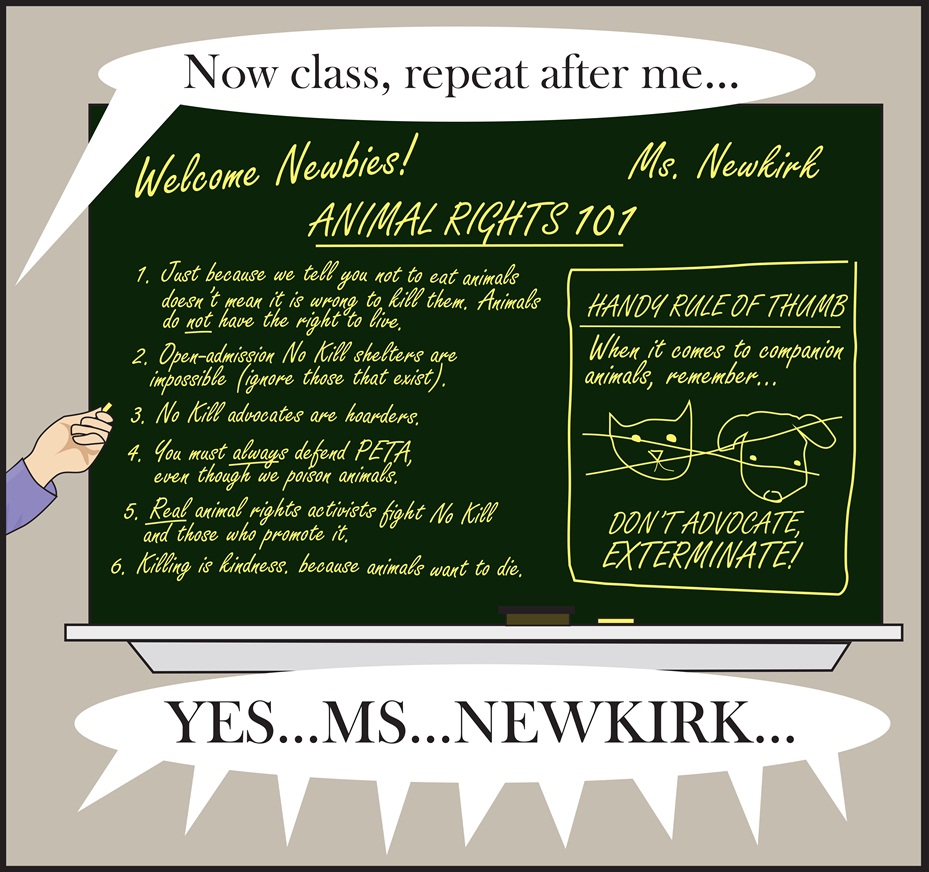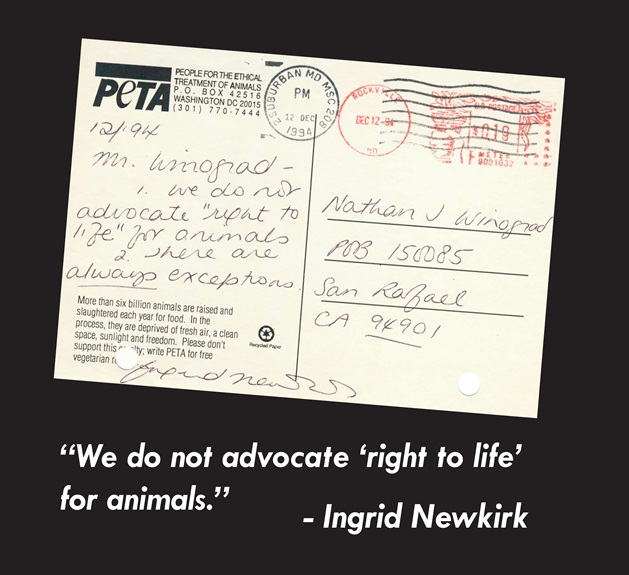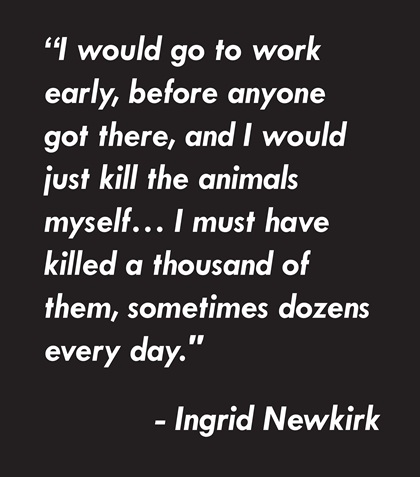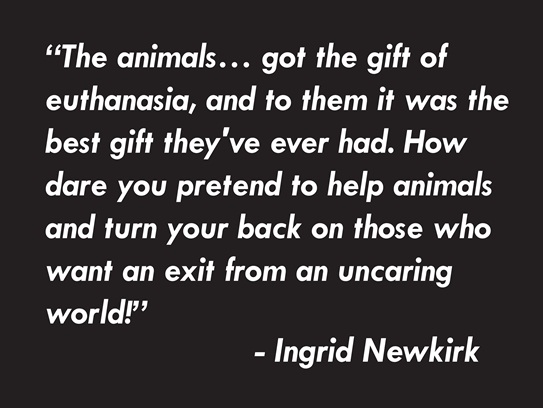By Nathan & Jennifer Winograd
“You’ve Got To Be Taught to Hate And Fear,
You’ve Got To Be Taught from Year To Year,
It’s Got To Be Drummed in Your Dear Little Ear
You’ve Got To Be Carefully Taught.”
— Oscar Hammerstein, South Pacific.
My son has to do a speech for a class on the U.S. Constitution. All the kids picked their topics, wrote their drafts and yesterday, they read their reports aloud to the others for feedback, in anticipation of next week when they will have to read it in front of classmates, schoolmates, teachers and parents. One of the kids read a speech on the need for animals to be given legal rights, a topic after my own heart. According to my son, his classmate spoke about abuse, about killing, about all the ways animals are exploited, dogs and cats among them. He talked about the many organizations that work to protect them, among which he mentioned one by name: PETA.
It was time for feedback and my son—the son of Redemption and Friendly Fire, the son of many discussions around the dinner table, the son who accompanied me on my national book tour, the son of a former shelter director, the son of the No Kill Advocacy Center—gave him an earful. The poor kid’s jaw nearly hit the floor. As my son recounted what had occurred, it became crystal clear to me: this young, aspiring animal rights advocate, who spoke of the evil of animal abuse, of exploitation, of how wrong it was that as a society we kill our best friends, had not yet been “carefully taught” to exclude dogs and cats from his sphere of concern. He had not yet been taught to champion their killing.
In his research about animal rights, he had not learned that PETA seeks out and kills thousands of animals a year—seven each and every day, a total of over 27,000 in the last decade. He had not yet come across PETA’s call for the round up and systematic slaughter of healthy street cats. He had not seen an image of the basket of cookies PETA sent a shelter in celebration of a proposed mass slaughter. He had not been told that if a dog has a blocky-head and someone labels that dog a “pit bull,” the dog can and must be taken from their family, killed, and then disposed of in a landfill or supermarket dumpster. He had not yet become indoctrinated with the view that killing is just like being put under anesthesia for spay/neuter except that the animal never wakes up, so it is not only ethically acceptable, it is morally obligatory. He had not yet read that saving animals is akin to hoarding, that shelters that save lives are “hellholes” while those that end them needlessly, even abusing them in the process, are filled with “angels.” He had not yet been spoon fed the line that only “fanatics” want to save dogs and cats. He had not yet been corrupted to believe that while some animals were worthy of compassion—animals such as cows, chickens, pigs, and fish—others were not; others, like dogs and cats, should be poisoned, should be needlessly butchered, should be put to death, so long as those putting them to death call themselves “shelters” or “animal rights organizations” and as long as those who champion such killing are vegan. In short, he had not yet been schooled in the fundamental lesson of the PETA philosophy: hypocrisy.
Because he loved animals, he did not want to see any of them killed and he had not yet bifurcated that belief to exclude companion animals. Instead, he believed they shouldn’t be killed either, calling for “due process” and “equal protection under the law” for all animals, regardless of species, regardless of who was doing the killing, regardless of reason. He was an animal rights advocate in its purest form—one that spoke and thought from his heart and not a head corrupted by the teachings of people who have contorted the meaning of the words and that noble effort beyond recognition. For him, the animals—all animals—still came first, and saving their lives the ultimate goal, while the idea that we should seek out dogs and cats to kill or that we should defend those who do was not a ghost of a thought in his loving, young, and uncorrupted mind. Thankfully, in his research for his paper he had yet to encounter members of PETA’s clone army—inauthentic animal “rights” activists who troll the internet and social media, vilifying those who remain consistent in their love across the animal kingdom.
Attack of the Clones
It is now as predictable as PETA’s killing itself, that every time No Kill activists cry foul in blogs and on Facebook pages about that killing, our movement experiences the influx and scrutiny of the PETA-lovers. Content to ignore our movement unless it is to defend those who kill, content to ignore that the No Kill movement is the single, most effective and uncompromising voice for the rights of dogs and cats, we are nonetheless paradoxically lectured and scolded by these individuals, people who put their allegiance to an organization that deliberately poisons thousands of animals every year, an organization headed by a seriously disturbed individual, before the values they claim to represent, as they condone PETA’s killing, and indeed, even celebrate it.
Try to imagine the scene at PETA headquarters, stacked high with furry bodies, on the day of the regularly scheduled visit from Tidewater Pet Cremation Services to which PETA delivers an estimated 30,000 tons of dead animals every year—no doubt making them one of that business’ “best” customers. How is it that the organization generally regarded as the nation’s largest “animal rights” organization is in fact creating piles of dead animals, killed by their own hand, while other animals rights “leaders” and legions of grassroots activists look the other way or defend them in this effort?
Stop almost any American on the street, and chances are pretty good that within just a few seconds of striking up a conversation about PETA’s killing—that once the person you are talking to overcame their initial disbelief that PETA routinely kills animals—she or he would be quick to condemn it. Yet strike up the same conversation with self-professed “animal rights activists” and you are likely to get a litany of excuses that condone and defend it. Unfortunately, those who should be the first and loudest to condemn PETA’s actions and fight for No Kill policies in our nation’s shelters are the least likely people to actually do so. To too many animal rights activists, animals have a right to life up until the moment they cross the threshold of either PETA headquarters or one of our nation’s shelters and then, they no longer do.
Who and what is to blame for this obvious contradiction? After all, no one enters the animal rights movement believing that cats and dogs are the exception to the rule. In fact, many people become animal rights activists as a result of a deep and meaningful relationship with a dog or a cat. Rather, it is a philosophy one must be schooled to accept and to champion. Animal rights activists who defend PETA’s killing of 2,000 animals a year and the killing of another four million in our nation’s pounds have to be taught to unlove dogs and cats.
I’ve written elsewhere how the need for identity and allegiance often trumps the lives of the animals for many animal rights activists. I’ve also written how PETA trains its supporters to squash their natural empathy for companion animals in order to convince them that killing them is the ultimate act of “love” because the animals “might someday suffer” and in fact, that killing is a “gift” because the animals themselves “want to die.” And I’ve written how supporters of PETA navigate the five stages of guilt to close off any critical thinking about their own corruption and hypocrisy: anger, defensiveness, denial, assertion of authority, and more anger. In other words, they will do as they are told. We know what went wrong for these individuals: they were carefully taught. But what went wrong in the movement?
Tragic Betrayals
As we write in Friendly Fire, although the last decade has seen the No Kill movement make unprecedented progress solving a crisis responsible for the deaths of millions of animals every year, there continues to be a deep bias against and ignorance about the No Kill movement within the animal rights community today. And while there are thankfully a growing number of animal rights activists who are making the leap to supporting No Kill, overall they remain the exception. Of course, PETA’s anti-No Kill propaganda is to blame for some of this confusion. The fact that PETA continuously equates No Kill with hoarding and animal suffering while lying to their followers about the “necessity” of killing cats and dogs is the primary factor contributing to this troubling paradox. But it is not the only one.
Like Ingrid Newkirk, many of the founders and employees working at our nation’s animal rights organizations came to animal rights by way of sheltering. This meant that they not only brought to the cause the historical excuses used to justify the killing of animals in shelters, but having had many animals die at their very hands, they needed a way to justify their own untoward behavior in light of their competing beliefs. To champion a cause that claims that animals have rights while at the same time having killed thousands of animals themselves required them to adopt an inconsistent philosophy to reconcile what in reality are diametrically opposing values. This view became firmly cemented within the animal rights movement when other animal right leaders, deferring to the “expertise” of their friends and colleagues who had worked in shelters, bought into the rationalizations and failed to challenge them. And so a deadly philosophical dichotomy emerged within the animal rights movement: one that held that all animals have a right to life, except those who enter shelters. This killing, it was argued, was necessary where the other kinds were not and those doing the killing were not to blame, but rather unsung heroes courageously performing the public’s dirty work.
In fact, efforts that focus on dogs and cats are often viewed with disdain and somehow “less animal rights” than other issues. Many animal rights activists erroneously believe the thousands of shelters across this country are in fact meeting the needs of these animals who therefore require no further advocacy or attention on their part. And they believe this because the people and organizations they trust to keep them informed about important issues affecting animals refuse to do so when the victims are not in factory farms or laboratories, but inside our nation’s animal shelters.
Today, healthy debate within the animal rights movement is discouraged in favor of “movement unity” and deference to the agendas promoted by large, powerful organizations. It is a top-heavy movement—and therefore intolerant of dissent, suspicious of change and prone to censorship. While many animal rights activists, lacking a sophisticated understanding of the pressing need for No Kill reform, underestimate and dismiss the cause as a mere “animal welfare” issue, leadership of animal rights organizations are not so naive and are far more calculating. They willfully ignore the No Kill movement and fail to champion its more widespread implementation precisely because it challenges the historical narrative they have used to explain and excuse shelter killing since the movement’s inception. In the animal rights movement today, innovations that threaten the prevailing paradigm are rejected in favor of the status quo.
You will find no mention of No Kill in the newsletters of large animal rights organizations. You are unlikely to find it mentioned on their websites, on their Facebook pages, nor any of the other ways these organizations regularly communicate with their members, except—in the case of PETA—to denigrate it. Likewise, No Kill is notably absent from the agendas of national animal rights conferences. Because the guidelines of these conferences mandate that speakers not criticize other animal protection organizations—even when doing so is required to expose their actions which harm animals and deny them their rights—No Kill advocates are under a gag order that prevents them from sharing the true causes of shelter killing as well as its proven cure—rejecting old philosophies and those who embody them. Within the animal rights community today, it is not what is right that matters, but who is right—even when they are clearly wrong. As a result, many animal rights activists continue to parrot the charade that the killing of innocent dogs and cats is acceptable, consistent with their beliefs that one should never kill pigs, cows or chickens.
This conspiracy of silence combined with an historical embrace of both the excuses used to rationalize the killing and those who promote them have coalesced to render the No Kill movement essentially invisible to most animal rights activists, except when it is being bashed and misrepresented by PETA. The so-called leaders of the animal rights movement keep grassroots activists ignorant and impotent, denying them the information necessary to see through PETA’s nefarious agenda and the tools they could use to assure lifesaving success at the shelters in their own communities. And while dogs and cats may come away as the most obvious losers, they are by no means the only ones.
For it is the public’s love and compassion for companion animals that could create profound social and legal precedents that would benefit all animals, such as laws making it illegal to kill them. A recent survey revealed that three out of four Americans already believe that shelters should not be allowed to kill healthy animals. Were such laws to be introduced, their passage would provide an important framework for future animal advocacy. History and the human rights movement predict that such a door, once opened, will, with time, be pushed ever wider to accommodate other species of animals currently being exploited or killed in other contexts. Yet the nation’s largest animal rights groups work to ensure that this door remains firmly shut, not only leaving vast potential that would benefit all animals lying untapped, but sacrificing their most fundamental ideals for the reputations of those who defend the killing and have schooled an entire generation of animal rights activists to do the same.
And it will only change when we force that door open, a task that will be made much easier when animal rights advocates are exposed to the truth before they become corrupted. It will be easier when animal rights advocates rekindle the compassion they once had for all animals before they were given the Orwellian lesson that killing is an act of love, rather than the act of violence it truly is. It will be easier when they take PETA’s famous question, “Why is one animal called dinner and another called a pet?” and ask it in reverse to come to an unassailable conclusion: If it is wrong to kill a cow or chicken or pig or fish (and I believe that it is), it is also wrong to kill a dog or cat.
A photograph from Friendly Fire:
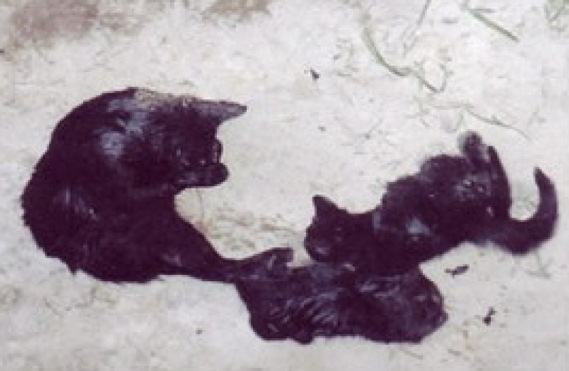
A dead mother cat and her two perfectly healthy kittens killed by PETA employees in the back of a van, a donor-funded death squad on wheels, minutes after promising a veterinarian that they would find them homes. According to the veterinarian’s testimony in court under oath, prior to giving them to PETA, the cat and kittens were in no danger of being killed.
For further reading:
—————-
Have a comment? Join the discussion by clicking here.
My Facebook page is www.facebook.com/nathanwinograd. Many people mistakenly believe that the Facebook pages at No Kill Nation and No Kill Revolution are my pages. They are not.
